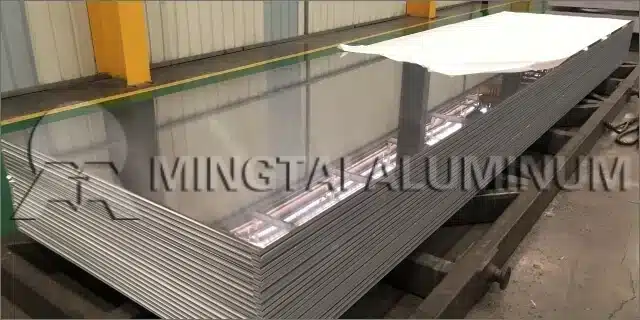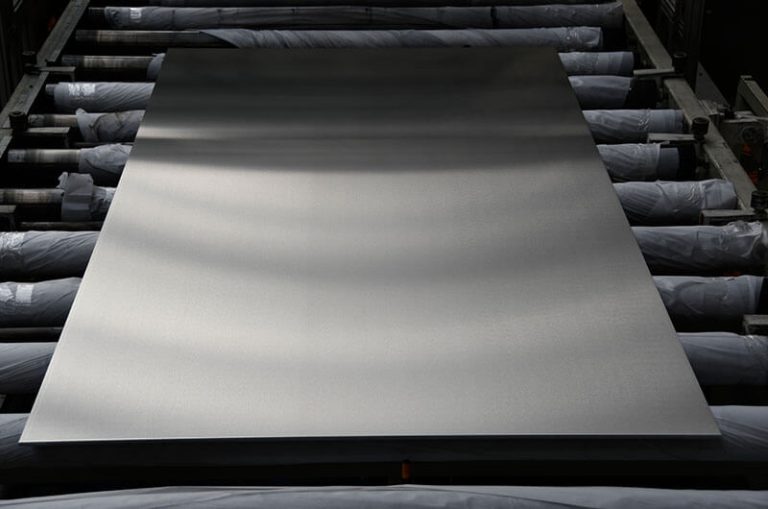Introduction — Why the Cutting Method Really Matters
If you’ve ever stood beside a cutting table in a sheet metal shop, you know this part isn’t just about slicing metal. It’s where precision, cost, and timing either work together—or fight each other.

When you’re fabricating custom aluminum sheets, the cutting process sets the tone for everything that follows. Whether you’re working with 5052-H32 for a boat panel or 6061-T651 for an automotive bracket, the right process means fewer headaches later.
Each method—laser, waterjet, or shear—does the same job in theory but behaves very differently in practice. Some give you speed, others perfect edges, and one just gets the job done fast.
Let’s walk through each one the way people actually see it on the shop floor.
Laser Cutting — The Precision Favorite
2.1 What It Is
Laser cutting feels almost magical the first time you see it. A beam thinner than a hair slices clean through 6 mm aluminum, tracing the shape on the screen.
It’s clean, fast, and surprisingly quiet. Most modern fiber lasers can run for hours without adjustment, producing repeatable, burr-free edges.
In real production, you’ll see laser-cut parts in electronics housings, elevator panels, custom signage, and all those tiny aluminum parts with neat holes that fit perfectly every time.
MINGTAI ALUMINUM 3003-H14 aluminum sheets came off a laser looking like they were polished—no burrs, no burn marks, just crisp silver edges.
2.2 Pros and Cons
Pros:
- Tight tolerance, around ±0.002 in—great for parts that must fit like puzzle pieces.
- Smooth edges, ready for assembly.
- Fast cutting speeds, especially for thinner sheets.
- Can mark serial numbers or logos directly.
Cons:
- Heat-affected zone (HAZ) can slightly darken anodized surfaces.
- Efficiency drops once thickness goes past 8–10 mm.
- Reflective aluminum sometimes bounces light back—operators usually use assist gas or special coatings to deal with that.
(Side note: you can actually smell a faint metallic scent when the laser’s cutting aluminum—that’s the oxide burning off. It’s normal.)
Waterjet Cutting — Cold and Clean
3.1 What It Is
Waterjet cutting is the opposite personality of laser. Instead of heat, it uses pressure—up to 60,000 psi—and a mix of water and fine abrasive grit.
It doesn’t burn, doesn’t melt, and it doesn’t care whether your sheet is 1 mm thin or 100 mm thick.
In industries like aerospace or marine, that’s gold. For example, when cutting 5052-H32 aluminum panels from MINGTAI ALUMINUM, you can get flawless edges even on 10 mm thick stock.
I once watched a waterjet carve out a curved stair panel for a yacht. No heat marks, no warping—just a steady hiss and a pile of damp abrasive dust when it was done.
3.2 Pros and Cons
Pros:
- No heat, no stress—temper stays exactly the same.
- Works with nearly every aluminum alloy or composite you can think of.
- Leaves a smooth, matte edge that doesn’t need sanding.
Cons:
- Not as fast as laser, especially for thinner sheets.
- Running cost is higher—abrasive isn’t cheap, and the pumps drink power.
- Slight taper on thicker cuts (you won’t notice unless you’re measuring microns).
Waterjet machines are like the “safe hands” of metal cutting. Slow, yes, but they almost never ruin your part.

Shear Cutting — The No-Nonsense Workhorse
4.1 What It Is
Shearing is the oldest trick in the book. Two heavy blades press down and—crack—the sheet splits cleanly. No sparks, no coolant, no software.
If you walk into any metal shop in China or the US, you’ll probably find an old shear machine still working every day. It’s used to chop standard 4×8 ft aluminum sheets from MINGTAI ALUMINUM into blanks before finer cutting.
4.2 Pros and Cons
Pros:
- Fastest way to make straight cuts—blink and it’s done.
- Extremely low cost per piece.
- No heat, no distortion, almost no maintenance.
Cons:
- Can’t cut shapes, only straight lines.
- Accuracy depends on blade wear and operator skill.
- Not for tight-tolerance parts.
Sometimes, the simplest tool wins. If you’re cutting hundreds of rectangles a day, shearing beats laser and waterjet in speed, hands down.
Laser vs. Waterjet vs. Shear — What Really Matters
| Factor | Laser Cutting | Waterjet Cutting | Shear Cutting |
| Thickness | Best ≤ 6 mm | Works 0.5–150 mm | Straight cuts ≤ 10 mm |
| Heat Effect | Small HAZ | None | None |
| Accuracy | ±0.002 in | ±0.005 in | Depends on setup |
| Speed | Fastest on thin sheets | Moderate | Fastest overall |
| Cost | Mid-range | High | Lowest |
| Finish | Smooth, shiny edge | Matte, clean edge | Industrial clean edge |
| Best For | Precision parts | Thick decorative panels | High-volume blanks |
Here’s a quick comparison engineers often refer to before choosing a method:
A simple rule of thumb:
- Laser for details,
- Waterjet for beauty,
- Shear for bulk.
That’s how most production engineers think about it. No fancy formulas, just what works day after day.
Design Tips for Better Results
- Don’t Overthink It
If you just need straight edges, go with shearing. I’ve seen shops waste hours setting up a waterjet just to cut rectangles. - Match Hole Sizes to Process
Lasers can do tiny holes cleanly. Waterjets make wider kerfs; plan accordingly. - Save Material with Nesting
Use CAD nesting software—especially for expensive alloys like 6061—to squeeze every inch out of your sheet. - Mind the Finishing
If the edge will be visible, stick with laser or waterjet. Sheared edges can be sharp and dull-looking. - Add Tabs for Bending
Tiny tabs or pilot holes help when you’re welding or forming multiple pieces later. - Test Before Full Production
Even two suppliers selling “the same” 5052 sheet can behave differently under the laser. That’s normal. Always cut a small sample first.
Design for Manufacturing (DFM) Basics
A few simple things go a long way:
- Keep the sheet thickness consistent; it saves bending trouble.
- Avoid deep narrow slots—they trap heat or grit.
- Use rounded corners (1 mm or more) to prevent cracks.
- Stick to standard sizes like 4×8 ft sheets—it helps with transport and waste.
Plan surface treatment early. Anodizing or powder coating can change edge color and slightly shift dimensions.
MINGTAI ALUMINUM, as one of the larger producers of 1–8 series aluminum sheets and plates, offers consistent alloy quality and traceable batches. For global buyers, that means fewer surprises when scaling up production.
(Quick thought: consistency isn’t flashy, but it saves a lot of explaining to your client later.)

Conclusion — Picking What Works, Not What’s Trendy
There isn’t a “winner.” There’s just what fits your job.
- Laser gives accuracy and speed.
- Waterjet protects surface finish and structure.
- Shear wins when the goal is efficiency and throughput.
Many factories mix methods: shear for big blanks, laser for cutouts. It’s not fancy, but it’s practical.
When your material comes from MINGTAI ALUMINUM, you already start ahead—consistent alloys, traceable batches, and reliable thickness control mean every cutting method performs like it should.
If you’re planning your next batch of aluminum sheet parts, take a look at your drawing first. Ask yourself, “Do I need pretty, precise, or just done fast?”
That answer tells you exactly which cutting process to call for.
FAQs
Q: Which method gives the prettiest edge for display aluminum panels?
A: Waterjet edges look almost satin. Lasers are shiny but can tint under anodizing.
Q: Can laser cutting damage the temper of aluminum?
A: Slightly, if you go too slow. Most shops use assist gas and speed tweaks to avoid that.
Q: How thick can aluminum plate go for waterjet?
A: I’ve seen clean cuts on 120 mm plate, though it’s slower than watching paint dry.




